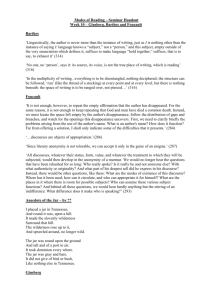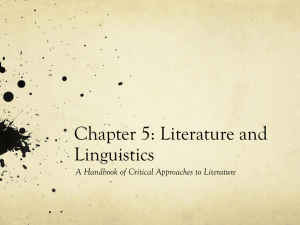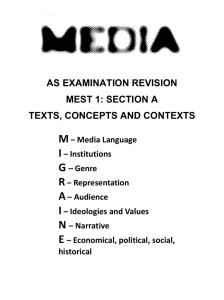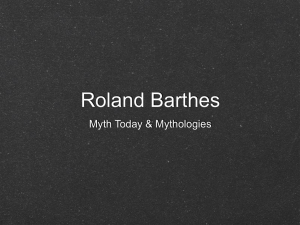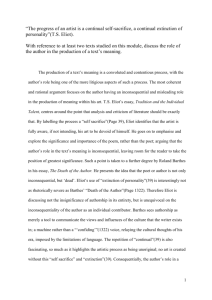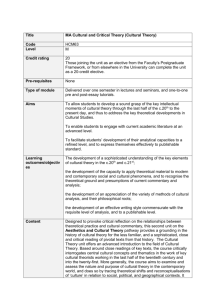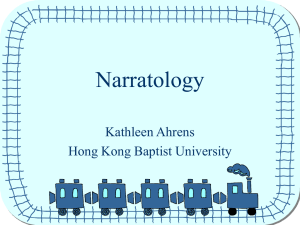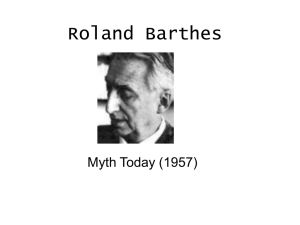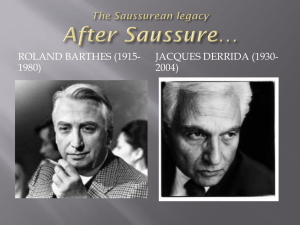On Writing and Drawing schedule and abstractsFINAL
advertisement
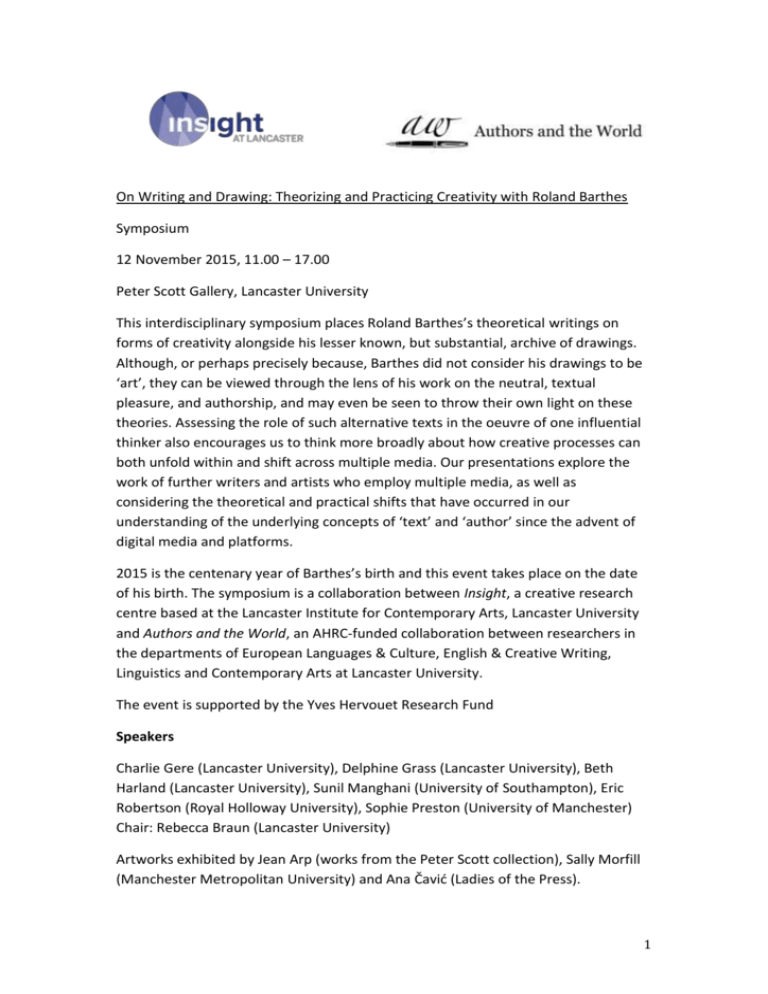
On Writing and Drawing: Theorizing and Practicing Creativity with Roland Barthes Symposium 12 November 2015, 11.00 – 17.00 Peter Scott Gallery, Lancaster University This interdisciplinary symposium places Roland Barthes’s theoretical writings on forms of creativity alongside his lesser known, but substantial, archive of drawings. Although, or perhaps precisely because, Barthes did not consider his drawings to be ‘art’, they can be viewed through the lens of his work on the neutral, textual pleasure, and authorship, and may even be seen to throw their own light on these theories. Assessing the role of such alternative texts in the oeuvre of one influential thinker also encourages us to think more broadly about how creative processes can both unfold within and shift across multiple media. Our presentations explore the work of further writers and artists who employ multiple media, as well as considering the theoretical and practical shifts that have occurred in our understanding of the underlying concepts of ‘text’ and ‘author’ since the advent of digital media and platforms. 2015 is the centenary year of Barthes’s birth and this event takes place on the date of his birth. The symposium is a collaboration between Insight, a creative research centre based at the Lancaster Institute for Contemporary Arts, Lancaster University and Authors and the World, an AHRC-funded collaboration between researchers in the departments of European Languages & Culture, English & Creative Writing, Linguistics and Contemporary Arts at Lancaster University. The event is supported by the Yves Hervouet Research Fund Speakers Charlie Gere (Lancaster University), Delphine Grass (Lancaster University), Beth Harland (Lancaster University), Sunil Manghani (University of Southampton), Eric Robertson (Royal Holloway University), Sophie Preston (University of Manchester) Chair: Rebecca Braun (Lancaster University) Artworks exhibited by Jean Arp (works from the Peter Scott collection), Sally Morfill (Manchester Metropolitan University) and Ana Čavić (Ladies of the Press). 1 Schedule 11.00 – 11.20 Coffee and introduction Rebecca Braun and Beth Harland 11.20 – 11.40 Sunil Manghani 11.40 – 12.00 Beth Harland 12.00 – 12.20 Eric Robertson 12.20 – 13.00 Round table discussion 13.00- 14.00 Lunch 14.00 – 14.20 Delphine Grass 14.20 – 14.40 Sophie Preston 14.40 – 15.00 Charlie Gere 15.00 – 15.40 Round table discussion 15.40 – 16.00 Coffee 16.00 – 17.00 Conclusions Abstracts Marks of Neutrality Sunil Manghani Barthes’ drawings are methodical, yet portray play. And while we might think them depictions of ‘nothingness’, their materiality (and the inscription of time) make for a certain archive, a diary, a study even in ‘idiorrhythmy’. This paper offers a ‘reading’ of Barthes’ practice of drawing and painting through the lens of the late lecture course Comment vivre ensemble and Le Neutre. A figure pertinent to both courses is of a school of fish, as a pattern of fluidity preserving ‘tactful’ spaces between. Crucially, for Barthes, Neutral ≠ neutrality; it is not divestment, but ‘an ardent, burning activity’, through which the world is revealed as an unsustainable will-tolive, untrammeled by our will-to-possess the sustainable. The paper takes its cue from one of the opening figures of Le Neutre: weariness, or fatigue. Similar in tone to the release we understand with jouissance, here the term is of depletion, a flattening out of the self, not a scattering. Quoting Blanchot, Barthes reminds us: ‘It seems that, however weary you may be, you still accomplish 2 your task, quite properly. One might say that not only does weariness not impede the work, but the work demands this being weary without measure’. Inevitably drawn to this ‘without measure’, Barthes suggests: ‘…weariness does not constitute an empirical time, a crisis, an organic event, a muscular episode – but a quasimetaphysical dimension, a sort of bodily (and not conceptual) idea, a mental kinesthesia: the tactile experience, the very touch of endlessness: I use its infiniteness as an accompaniment of my work’. This paper, then, considers Barthes’ paintings as a ‘bodily idea’ and as a form of accompaniment. In doing so, the paper also considers how we might locate the neutral in other works, with particular reference to Gauguin's Green Christ (1889) and Ishiguro’s The Remains of the Day. Sunil Manghani is Reader in Critical and Cultural Theory and Director of Doctoral Research at the Winchester School of Art, University of Southampton. He is the author of Image Studies: Theory and Practice (Routledge, 2013); Image Critique & the Fall of the Berlin Wall (Intellect, 2008); editor of the four-volume anthology Images: Critical and Primary Sources (Bloomsbury, 2013); and co-editor of Images: A Reader (Sage, 2006), an anthology of writings on the image from Plato to the present; and Painting: Critical and Primary Sources (Bloomsbury, 2015). He is also coeditor of Farewell to Visual Studies? (Penn State University Press, 2015) and an associate editor for Theory Culture & Society. Drawing as Drift: Roland Barthes’s drawings and the pleasure of the margin Beth Harland When Roland Barthes described the value of his own works, he privileged the margins, the parentheses, as the site of greatest contribution. It is here, ‘aslant’ and ‘offstage’ that the making, and the pleasure, of the numerous paintings and drawings that he produced in the 1970s alongside his writing practice reside. This paper responds to these visual works in relation to Barthes’ writings and explores what they suggest about the roles of writer/reader. His position of challenge to the view that the writer is active behind the text while the reader remains passive before it is also engaged here in terms of the painter/spectator relationship. The pleasure of the text, for Barthes, takes the form of drift: “…like a cork on the waves, I remain motionless, pivoting on the intractable bliss that binds me to the text (to the world)” (Barthes, The Pleasure of the Text 1975). The importance of drift surfaces in a number of his writings, as a means of remaining mobile, detached, capable of ‘contemplative duration’. The paper considers Barthes’ paintings and drawings in these terms, and explores their qualities of graphism, colour and spatial 3 construction with reference to works by other thinkers on these subjects, in particular Hubert Damisch’s Theory of /Cloud/(2002). Beth Harland is Professor of Fine Art at Lancaster University (UK) and Director of Insight, a research centre at Lancaster University. She is an artist and writer, specializing in pictorial practice. She is Associate Editor of the Journal of Contemporary Painting (Intellect) and leads the Modes of Address research project in collaboration with the Centre for Visual Cognition, University of Southampton (Leonardo 2014). She is co-editor of Painting: Critical and Primary Sources (Bloomsbury, 2015); author of A Fragment of Time in the Pure State; Painting in Search of Haptic Time (Journal of Visual Art Practice, 2009) and editor of Behind the Eyes; Making Pictures, a collection of works and writings by contemporary painters (RGAP, 2013). Between Line and Sign: Barthes’s Writings on Art Eric Robertson This paper will consider Barthes’s engagement with artworks that inhabit the boundary between drawing or painting and forms of writing. These trigger in Barthes a response that is profound yet seemingly paradoxical: in the first instance, his approach is that of the semiotician, intent on accounting for the artwork as part of a larger signifying system. Yet we find him increasingly accentuating those respects in which the artwork resists just such categorisation. Rather than opening up a space for purely theoretical speculation, the artworks that fascinate him resist codification and become instead the site of a unique and unrepeatable physical encounter as the marks on the picture surface bear the palpable traces of the artist’s body. Considering Barthes’s essays on artists such as André Masson, Bernard Réquichot and Cy Twombly, the paper will assess their importance for Barthes’s thinking about art and textuality alike. Eric Robertson is Professor of Modern French Literature and Visual Arts at Royal Holloway, University of London, where he specialises in modern French and European literature and visual arts, the literary and artistic avant-garde movements of the twentieth century, and literary bilingualism. He is the author of Arp: Painter, Poet, Sculptor (2006, awarded the 2007 R. H. Gapper Book Prize), Writing Between the Lines: René Schickele, 'Citoyen frança̜ is, deutscher Dichter’, 1880-1940 (1995), and Picturing Modernity: Blaise Cendrars and the Visual Avant-Gardes (forthcoming). He is the co-editor of Yvan Goll - Claire Goll: Texts and Contexts (1997), Robert Desnos: Surrealism in the Twenty-First Century (2006), Dada and Beyond Vol 1: Dada Discourses (2011) and Dada and Beyond Vol 2: Dada and its Legacies (2012) and has 4 authored numerous chapters and articles on various aspects of the European avantgardes. Current projects include a new book on Arp and a study of avant-garde art and virtual technologies. Arp and Barthes: Writing the Senses Delphine Grass This paper will explore the relationship between semantic meaning, voice and drawing in Arp and Barthes. Hans/Jean Arp’s poetic works are characterised by his interest in the sensuality and concreteness of words in German and French. Conversely, his works as a visual artist can be said to question the formative role of language in visual creativity and our perception of space. This paper will offer a comparative reading of the importance of the voice in Arp’s “seismic lines” period and Barthes’s notion of “rustling” in literary language. Delphine Grass is a lecturer in French studies at the University of Lancaster. Her research focuses on modern and contemporary French literature and theory. She is currently working on a monograph: Michel Houellebecq, Literature and Aesthetics in the Era of Globalisation. The monograph develops the theoretical framework of framelessness, which is used to approach the portrayal of globalisation in Houellebecq’s texts through a variety of themes, such as tourism, architecture, cloning and religion. Her next research project focuses on twentieth-century modernist poetry from Alsace-Lorraine and the poetics of multilingualism, community and statelessness in these poets' critique of nationalist politics. She is also a practicing poet and poetry translator. Drawing to write: Marcel Proust, Roland Barthes, Cy Twombly Sophie Preston The writings and drawings of Marcel Proust (1871-1922), Roland Barthes (19151980) and Cy Twombly (1928-2011) all touch. Their lifetimes overlapped and their literary and visual output was taken up in turn. Barthes, read and wrote about Proust's long novel, In Search of Lost Time. He wrote two essays about the art of Twombly, and attempted to paint like him too. Twombly read Proust’s Search in the latter part of his life and co-curated an exhibition of his own photography, inspired in part by the novel. Proust, Barthes and Twombly each saw drawing in close relationship to writing; Proust illustrated his private letters and draft manuscripts, Barthes painted hundreds of doodled works as part of his writing practice; and 5 Twombly drew text in his paintings, often appropriated and rewritten from literature. Juxtaposed they form a series of literary and visual encounters. This paper will introduce narratives of ‘drawing to write’ in the work of two writers and one painter. Sophie Preston is a PhD candidate in Art History at the University of Manchester under the supervision of Professor Carol Mavor working on a thesis entitled 'Drawing to write: the words and images of Marcel Proust, Roland Barthes and Cy Twombly'. Alongside her research Sophie works on public engagement projects and has recently curated an exhibition and community engagement program at the Pankhurst Centre, entitled 'Squatting to be Saved: The Living History of the Pankhurst Centre' funded by the University of Manchester. "Stupid like a Painter". Barthes, Derrida and the mutism of art Charlie Gere This paper starts with the 19th century French phrase 'bête comme un peintre', stupid like a painter, and moves to Barthes' essay 'Is Painting a Language' to explore the idea that painting is necessarily dumb, meaning both mute and stupid, and that this is a good thing. I will take in Derrida on the taciturnity and mutism of the visual arts, and his analysis of the relation between the beast (bête) and the sovereign, before returning to Barthes and his own drawings and paintings as sites of resistance to the will to mastery of discourse. Charlie Gere is Professor of Media Theory and History in the Lancaster Institute for Contemporary Arts, Lancaster University. He is the author of Digital Culture (2002), Art, Time and Technology (2006), Non-relational Aesthetics, with Michael Corris (2009), and Community without Community in Digital Culture (2012)as well as coeditor of White Heat Cold Technology (2009), and Art Practice in a Digital Culture (2010), and many papers on questions of technology, media and art. In 2007 he cocurated Feedback, a major exhibition on art responsive to instructions, input, or its environment, in Gijon, Northern Spain, and was co-curator of FutureEverybody, the 2012 FutureEverything exhibition, in Manchester. 6
